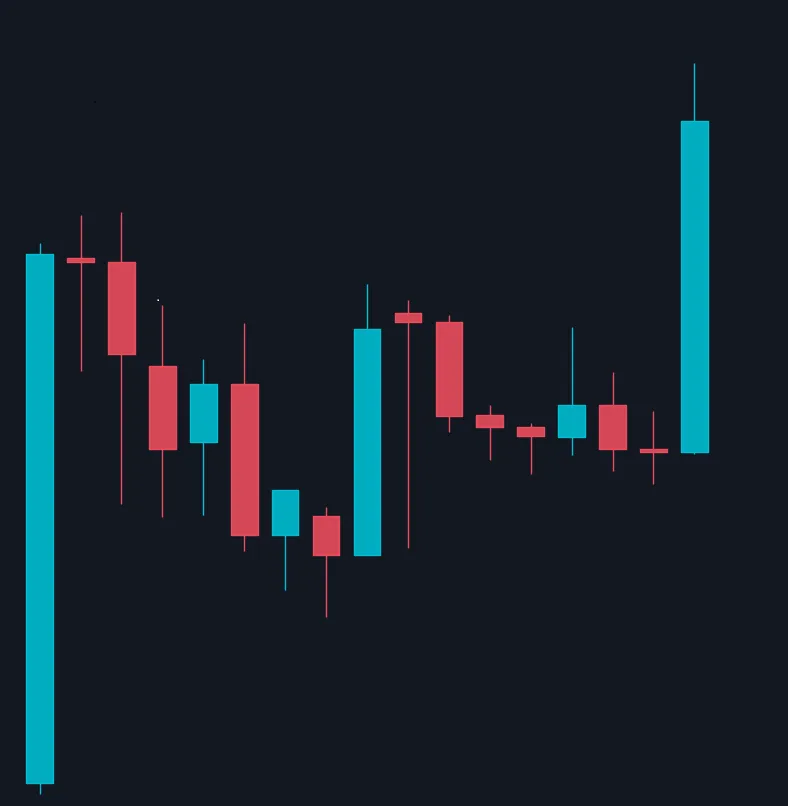我有以下一组OHLC数据:
[[datetime.datetime(2020, 7, 1, 6, 30), '0.00013449', '0.00013866', '0.00013440', '0.00013857', '430864.00000000', 1593579599999, '59.09906346', 1885, '208801.00000000', '28.63104974', '0', 3.0336828016952944], [datetime.datetime(2020, 7, 1, 7, 0), '0.00013854', '0.00013887', '0.00013767', '0.00013851', '162518.00000000', 1593581399999, '22.48036621', 809, '78014.00000000', '10.79595625', '0', -0.02165439584236435], [datetime.datetime(2020, 7, 1, 7, 30), '0.00013851', '0.00013890', '0.00013664', '0.00013780', '313823.00000000', 1593583199999, '43.21919087', 1077, '157083.00000000', '21.62390537', '0', -0.5125983683488642], [datetime.datetime(2020, 7, 1, 8, 0), '0.00013771', '0.00013818', '0.00013654', '0.00013707', '126925.00000000', 1593584999999, '17.44448931', 428, '56767.00000000', '7.79977280', '0', -0.46474475346744676], [datetime.datetime(2020, 7, 1, 8, 30), '0.00013712', '0.00013776', '0.00013656', '0.00013757', '62261.00000000', 1593586799999, '8.54915420', 330, '26921.00000000', '3.69342184', '0', 0.3281796966161107], [datetime.datetime(2020, 7, 1, 9, 0), '0.00013757', '0.00013804', '0.00013628', '0.00013640', '115154.00000000', 1593588599999, '15.80169390', 510, '52830.00000000', '7.24924784', '0', -0.8504761212473579], [datetime.datetime(2020, 7, 1, 9, 30), '0.00013640', '0.00013675', '0.00013598', '0.00013675', '66186.00000000', 1593590399999, '9.02070446', 311, '24798.00000000', '3.38107106', '0', 0.25659824046919455], [datetime.datetime(2020, 7, 1, 10, 0), '0.00013655', '0.00013662', '0.00013577', '0.00013625', '56656.00000000', 1593592199999, '7.71123423', 367, '27936.00000000', '3.80394497', '0', -0.2196997436836377], [datetime.datetime(2020, 7, 1, 10, 30), '0.00013625', '0.00013834', '0.00013625', '0.00013799', '114257.00000000', 1593593999999, '15.70194874', 679, '56070.00000000', '7.70405037', '0', 1.2770642201834814], [datetime.datetime(2020, 7, 1, 11, 0), '0.00013812', '0.00013822', '0.00013630', '0.00013805', '104746.00000000', 1593595799999, '14.39147417', 564, '46626.00000000', '6.39959586', '0', -0.05068056762237037], [datetime.datetime(2020, 7, 1, 11, 30), '0.00013805', '0.00013810', '0.00013720', '0.00013732', '37071.00000000', 1593597599999, '5.10447229', 231, '16349.00000000', '2.25258584', '0', -0.5287939152480996], [datetime.datetime(2020, 7, 1, 12, 0), '0.00013733', '0.00013741', '0.00013698', '0.00013724', '27004.00000000', 1593599399999, '3.70524540', 161, '15398.00000000', '2.11351192', '0', -0.06553557125171522], [datetime.datetime(2020, 7, 1, 12, 30), '0.00013724', '0.00013727', '0.00013687', '0.00013717', '27856.00000000', 1593601199999, '3.81864840', 140, '11883.00000000', '1.62931445', '0', -0.05100553774411102], [datetime.datetime(2020, 7, 1, 13, 0), '0.00013716', '0.00013801', '0.00013702', '0.00013741', '83867.00000000', 1593602999999, '11.54964001', 329, '42113.00000000', '5.80085155', '0', 0.18226888305628908], [datetime.datetime(2020, 7, 1, 13, 30), '0.00013741', '0.00013766', '0.00013690', '0.00013707', '50299.00000000', 1593604799999, '6.90474065', 249, '20871.00000000', '2.86749244', '0', -0.2474346845207872], [datetime.datetime(2020, 7, 1, 14, 0), '0.00013707', '0.00013736', '0.00013680', '0.00013704', '44745.00000000', 1593606599999, '6.13189248', 205, '14012.00000000', '1.92132206', '0', -0.02188662727072625], [datetime.datetime(2020, 7, 1, 14, 30), '0.00013704', '0.00014005', '0.00013703', '0.00013960', '203169.00000000', 1593608399999, '28.26967457', 904, '150857.00000000', '21.00600041', '0', 1.8680677174547595]]
那看起来像这样:
 我正在尝试在其他一组OHLC数据中检测类似上述图案的模式。它不必完全相同,只需要是相似的,即蜡烛数量不一定相同,只需要形状相似。
我正在尝试在其他一组OHLC数据中检测类似上述图案的模式。它不必完全相同,只需要是相似的,即蜡烛数量不一定相同,只需要形状相似。问题是: 我不知道从哪里开始才能实现这一点。我知道这并不容易,但我相信有一种方法可以做到这一点。
我已经尝试过: 到目前为止,我只设法手动削减掉我不需要的OHLC数据,以便我只拥有我想要的模式。然后,我使用Pandas DataFrame绘制了它。
import mplfinance as mpf
import numpy as np
import pandas as pd
df = pd.DataFrame([x[:6] for x in OHLC],
columns=['Date', 'Open', 'High', 'Low', 'Close', 'Volume'])
format = '%Y-%m-%d %H:%M:%S'
df['Date'] = pd.to_datetime(df['Date'], format=format)
df = df.set_index(pd.DatetimeIndex(df['Date']))
df["Open"] = pd.to_numeric(df["Open"],errors='coerce')
df["High"] = pd.to_numeric(df["High"],errors='coerce')
df["Low"] = pd.to_numeric(df["Low"],errors='coerce')
df["Close"] = pd.to_numeric(df["Close"],errors='coerce')
df["Volume"] = pd.to_numeric(df["Volume"],errors='coerce')
mpf.plot(df, type='candle', figscale=2, figratio=(50, 50))
